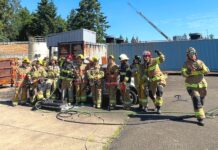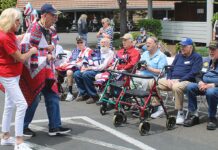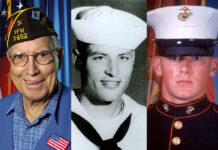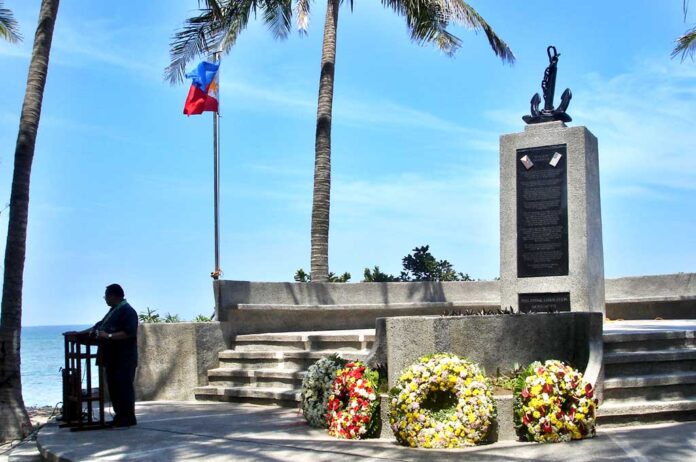
While unloading critical war supplies for Pilipino guerillas on August 27, 1944, the American Submarine, USS Stingray, was trapped in a Philippine bay by Japanese war ships. Tualatin resident Albert “Monty” Montague was a crewmember of the Stingray and involved in her defensive actions. The submarine had unloaded 15 American-Filipino commandos and nearly six tons of equipment – guns, ammo, food, radios and transmitters, and medical supplies – when their radar detected a nearby Japanese convoy on a course heading directly to the Luzon bay where Stingray was anchored.
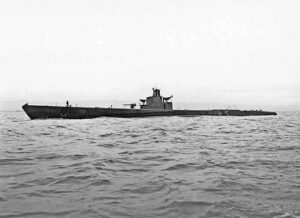
Stingray’s classified “Special Mission” started in Darwin, Australia where security was so tight, the sub anchored some distance away from the dock. Monty, a quartermaster, remembers when the commando’s came aboard. He was watching a movie in the bow of the sub. Soon thereafter, on August 16, 1944, Stingray left Australia with the commandos and ten tons of supplies, on a top secret mission to Luzon which is the largest island in the Philippines. Luzon contains the country’s capital city, Manila, and half the country’s population. There are only three islands in the world, one being Great Britain, that have more people.
It was difficult for Stingray to locate the landing spot. Part of the problem was that North Luzon was on Taiwan sea traffic lanes for the Japanese so sub crew had to be cautious to avoid being detected. The landing area provided natives the ability to transport war materials, along with the commando’s, through the jungle up the mountains to the guerillas. Called Bolomen, these natives were fiercely loyal and resourceful. Their name Bolomen came from their use of a long heavy one-edged knife used to cut through jungle and also their main weapon, called a Bolo.
After reaching the Philippines on August 25, evasive maneuvers were needed several times to avoid enemy ships peppering them with depth charges. Searching the Northern Luzon shoreline, a suitable landing spot was located at Caunayan Bay, at Pubudpud, Ilocos Norte. When first approaching the site in the bay, the Stingray ran aground on a reef. The Captain ordered engines to move the sub back at full speed and the sub bounced a few times while sliding free. He then anchored at 14 fathoms (84 feet) depth, about 650 yards from the beach. While this was happening, natives built a huge bonfire on the beach. An attempt was made to attach a cable between the shore and the submarine to assist the rubber rafts that would haul the materials ashore. But the line got caught in the sub’s port propeller. A crewmember in diving gear quickly cleared the line from around the propeller.
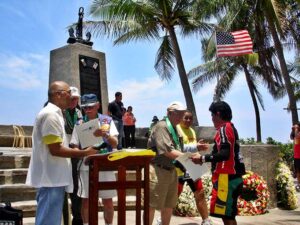
The supplies were being transported to the beach when enemy ships were first detected, about two miles eastward. They visually appeared to be several destroyers escorting a convoy. The unloading continued as the Captain considered his choices. If he decided to dive and head out, the destroyers would hear the Stingray. Also the remaining stores on deck would float, outlining their location. Lifting the anchor would also create noise. He decided to lay low and continue unloading. The main portion of the sub was immersed (water awash on the deck) so all that was visible above the water was the conning tower. The Captain figured that in the dark, the conning tower would look like the sail on a sail boat. He had all guns on deck armed and manned, with all sailors lying on the deck.
Left Sea Anchor in Bay
That first convoy passed within 450 yards of the Stingray. The Captain figured that the land background kept convoy from identifying the sub in advance but was sure they had sighted Stingray as they passed. An hour and a half later another convoy of 14 ships passed by at 300 yards. They appeared to not notice the Stingray. The Captain decided it was time to leave. He had the remaining stores (about four tons) moved back into the submarine, parted his anchor and chain (left them in bay) and departed.
There were a lot of tempting Japanese targets but attracting them would compromise the mission, alert the Japanese of the landing point. The Stingray dived, went underwater at 5:50 am on Aug 28 and did not surface at sea until 10:18 pm.
While awaiting the first convoy, the Captain had the ship wired with explosives and the crew prepared to jettison classified material and to go ashore. The explosives would also set off the torpedoes, so there would be nothing for the Japanese to recover. Monty was the quartermaster on the deck. He said that when the Captain moved near him, the Captain asked what the bulge was under his jacket. Monty replied “It is my life jacket in case we have to go ashore”. The Captain agreed it was a good idea and put his on as well.
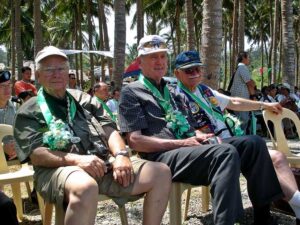
Deck log pages from that day include two conversations. One was between “two seamen lying on their bellies on the foo’sle (forward part of sub). One asks the other ‘Are you praying. The second replies ‘no’. The first responds ‘why in the hell aren’t you?’ The other involved the gunnery officer finding the ship’s cook rummaging around the pile of stores on deck. He asked him why he wasn’t lying down on deck as ordered. The cook replied, “Sir, I’m looking around for something that will float.”
Several other submarines delivered war materials in the same “Special Mission” but the Stingray was the first. These supplies helped guerilla forces harass Japanese military with ambushes and attacks from the inland. Also critical radio reports provided Gen MacArthur’s staff with Japanese force locations, weaponry and number of soldiers. Two months later, General MacArthur did return to the Philippines.
An American had a major role in this operation, Navy Reserve Lieutenant Charles “Chick” Parsons. Now deceased and a highly decorated retired Navy Commander, Parsons had operated a stevedoring company and other businesses in the Philippines before the war. He knew the Pilipino shoreline and its people well. One of his positions was as the temporary Panamanian consul to deal with ships operating under Panama flag. Since he had identification papers and valid documents in Manila’s government house, he remained as an official of a neutral company, while conducting intelligence operations and subverting enemy activities. Eventually, the Japanese grew to distrust all Caucasians and he was arrested and interned. He and his family were released because of his diplomatic status and allowed to leave the country in 1942. He settled his family in the United States and offered his services to help Allied forces in the Pacific. He is credited with the idea of using submarines to transport war materials and coordinated the operation. His extensive knowledge of the country and its culture plus an established network of trusted contacts made it possible for him travel throughout the country, to organize and maintain extensive intelligent networks and Coastwatcher radio stations, which transmitted Japanese troop movements to allied forces. In 1944, he returned nine days ahead of MacArthur to help prepare the guerrillas for the invasion. Later, he accompanied the first troops into Manila where he arranged supplies for the starving civilians newly liberated from the infamous Santo Tomas Internment Camp. After the war, Parsons resumed his business activities in Manila and assisted in rebuilding the country.
It took 50 years for the military to declassify this “Special Mission”. On April 21, 2007, Philippine officials dedicated a monument at the landing location. The monument is crowned with an anchor with a few feet of chain. Monty says the Stingray’s 2.000 pound anchor is encased in coral and the anchor chain is long gone. Monty was there with two other Stingray crewmembers. Others honored at the event included surviving Bolomen, Guerilla leaders and members, their families and families of others involved who are no longer living, including the Parsons family.,
The monument is inscribed:
Anchored in Freedom
Enshrined in Friendship
N 18-38.7 latitude, E 120-150 Longitude
Dimonto coma lipaten ti pateg ti pinilida
a pinagbayad gupu ken Wayawaya
That we may never forget the price they chose to pay for freedom
Author’s note: this is the last of a series of three columns about Monty’s WWII war experiences. First was his surviving Bombing of Pearl Harbor. The second covered highlights of his submarine service in the Pacific. Monty plans to return to the Philippines with his wife Opal where he is invited to participate in this year’s Dec 7th Pearl Harbor commemoration. They will stay at the hotel in Manila that General MacArthur used for his headquarters.

